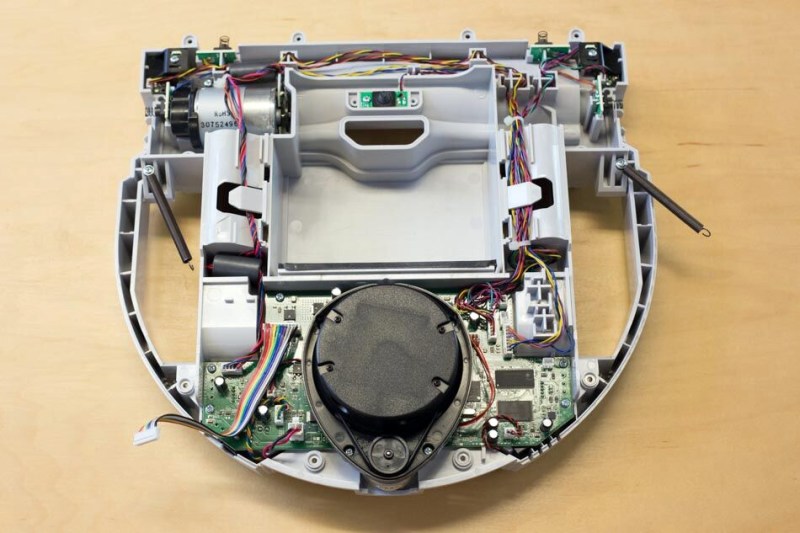Fictiv runs a 3D printing shop. They have a nice interface and an easy to understand pricing scheme. As community service, or just for fun, they decided to tear-down two robot vacuums and critique their construction while taking really nice pictures.
The first to go is the iRobot 650 model. For anyone who’s ever taken apart an iRobot product, you’ll be happy to know that it’s the same thousand-screws-and-bits-of-plastic ordeal that it always was. However, rather than continue their plague of the worst wire routing imaginable, they’ve switched to a hybrid of awfulness and a clever card edge system to connect the bits and pieces.
The other bot is the Neato XV-11. It has way fewer screws and plastic parts, and they even tear down the laser rangefinder module that’s captured many a hacker’s attention. The wire routing inside the Neato is very well done and nicely terminated in hard-to-confuse JST connectors. Every key failure point on the Neato, aside from the rangefinder, can be replaced without disassembling the whole robot. Interestingly, the wheels on both appear to be nearly identical.
In the end they rate the Neato a better robot, but the iRobot better engineered. Though this prize was given mostly for the cleverness of the card edge connectors.
















It took a while for the webpage to load, then the screen was greyed out by another page that wanted my email address, ( there was a bypass at the bottom of the page).
But it is an interesting tear down. Back when I repaired TV’s for a living, I had a rule of thumb, “the more screws it takes to remove the back, the cheaper it is built”. That sort of applies to Neato.
Not sure where they rate Neato a better robot…however in the end what matters is how the end result of the cleaning is, and not how well wires are routed.
I have to agree altough I have own a Roomba for many years. Still going strong.
However I think they both clean the room well, atleast I’m really satisfied with Roomba’s results.
But engineers need to know which one is better, usually TECHNICALLY :)
This must be the worst tear-down i have ever seen but it looks like they have fun.
Card edge connectors, sounds like trouble is in the offing. In a vacuum no less, …dust!
In my experience the number of non hard soldered wired connections equates to the trouble and unreliability that is extant.
Years ago the FAA was shamed in congress for it’s condition and a senator held up a vacuum tube and said this was what was wrong with the outdated radar and ATC systems. I read in the IEEE times that card edge connectors were the fault.
For years we sold the finest home organ, made just over in the next state. Years later the plug-in circuit board’s connectors are s**t, and some of the fuddy-duddy brands are still running unrepaired. Hammond also did the same going from the tonewheels to a boatload of boards with Molex edge connectors, …crap!
Then. Service is so simple, just unplug the bad board and insert the new board.
Today. Service is simple, just wiggle board connectors in suspect area, If you hear changes including proper operation, turn it off. Proceed with cleaning as best as you can for a repair that might last a year or two, every dammed connector in the whole mess. There won’t be any problem in the boards, save some touch up soldering.
I modded an electric toothbrush to hold a piece of Tyvek and solvent on a blade for in and out cleaning in the slot of the Molex edge connectors.
… this teardown … tears me apart. I tried watching both videos and i called it quits.
The “moody” music, the artsy camera shots (focusing on a small detail yet blurring the 90% of the robot)…
I cannot sincerely understand half the words they are saying (no proper mic setup), etc…
Yes. Gave up. Amateurs…. They stripped it down without reference to manuals etc. If you are going to strip down a device that costs many $$$, then RTFM… (Engineers and true techs will understand.).
The Neato was a lot better designed (with repair in mind) than most modern electronic devices I come across.